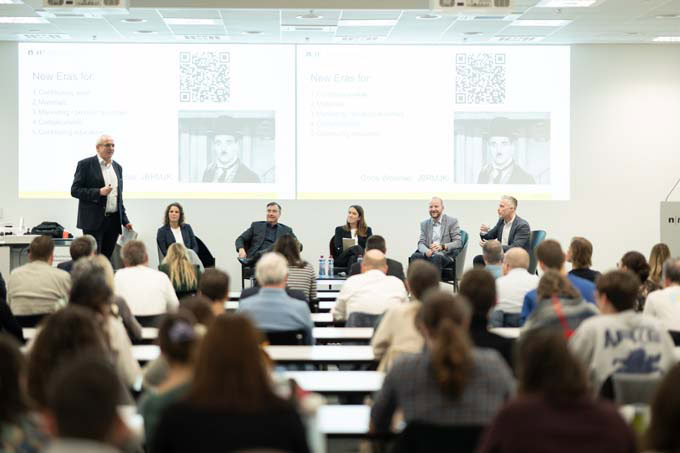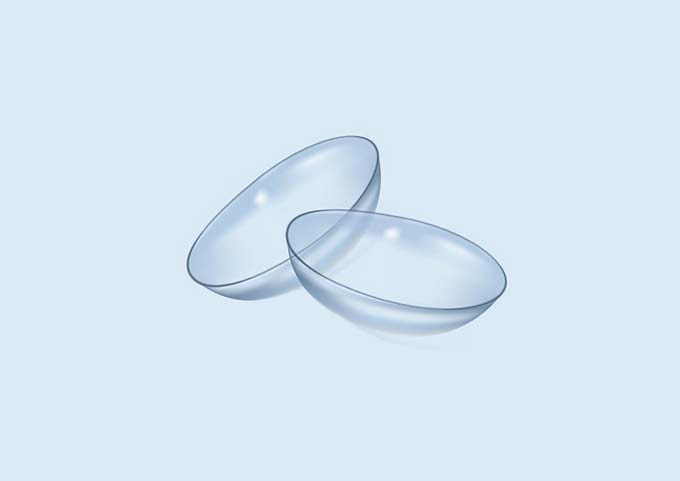The future of contact lenses - when visual aids become smart sensors
An evening with Prof. Lyndon Jones showed how contact lenses could soon detect diseases, deliver medication and even project valuable information directly into the eye.

With every last seat filled, the audience at the FHNW was given a fascinating glimpse into the future of contact lenses. During the lecture «The Future of Contact Lens», the internationally renowned researcher Prof. Lyndon Jones from the Centre for Ocular Research & Education (CORE) at the University of Waterloo (Canada) with visionary developments relating to the inconspicuous lens in the eye.

This event was kindly organized by the Association des Optométristes Romands (AOR), Interlens, Organization for Swiss Optometry (OSO), Mediconsult and Sensimed supported.
From vision correction to therapy
Today, modern contact lenses can do much more than compensate for visual defects: they can detect diseases, monitor bodily functions and administer medication in a targeted manner via the tear film. So-called „drug-delivery“ contact lenses enable the controlled release of medication over several hours - a major advance compared to conventional eye drops, which are often rinsed out after just a few minutes.
New diagnostic applications are also emerging: Sensor-containing contact lenses can measure intraocular pressure, the composition of tear fluid and even biomarkers for diseases such as diabetes, cancer or Alzheimer's. Research projects are investigating how such lenses could contribute to the early and non-invasive detection of systemic diseases.
Smart lenses with energy from tear fluid
One of the remaining challenges is the energy supply for contact lenses. Innovative approaches - such as ultra-thin batteries that generate electricity from the chemical composition of the tear fluid - show the potential of sustainable solutions. At the same time, Bluetooth and NFC technologies are being tested to securely transmit measurement data from the lens in the eye to recording devices such as smartphones.
«We are on the verge of experiencing contact lenses that not only correct vision, but also measure, heal and transmit information to the wearer.» - Prof. Lyndon Jones.
3D printing, artificial intelligence and augmented reality
Digital technologies are further accelerating innovation. With the help of 3D printing, researchers can produce customized contact lenses that are precisely tailored to the anatomy of each individual eye - including those with embedded drug reservoirs or optical elements. Artificial intelligence already supports the analysis of tear film images and the diagnosis of diseases such as «dry eye».
But the future goes even further: augmented reality contact lenses could one day project information directly into the field of vision - for navigation, training or medical education, for example.
Influence of developments on the Swiss lens market
In the subsequent panel discussion with industry experts Sarah Ven (AOR), Seonaid Collins (Optometry Center Basel), Daniel Ulrich (J&J Vision), Daniel Roos (Alcon) and Philippe Seira (FHNW), the importance of research, training and responsibility in the application of new technologies was emphasized. «The contact lens of the future will be more intelligent, but also more demanding to use. Innovation and education must go hand in hand,» emphasized the panel.

Looking ahead
Whether for treating eye diseases, measuring health data or as an interface for augmented reality - the future of the contact lens has long since begun. The combination of material science, electronics and artificial intelligence promises to change vision and ophthalmology in the long term.
FHNW research projects
Association between corneal nerve function, morphology and dry eye disease (DED) - https://www.fhnw.ch/de/die-fhnw/hochschulen/ht/institute/forschungsprojekte/assoziation-zwischen-hornhautnervenfunktion-hornhautmorphologie-und-dem-trockenen-auge.








